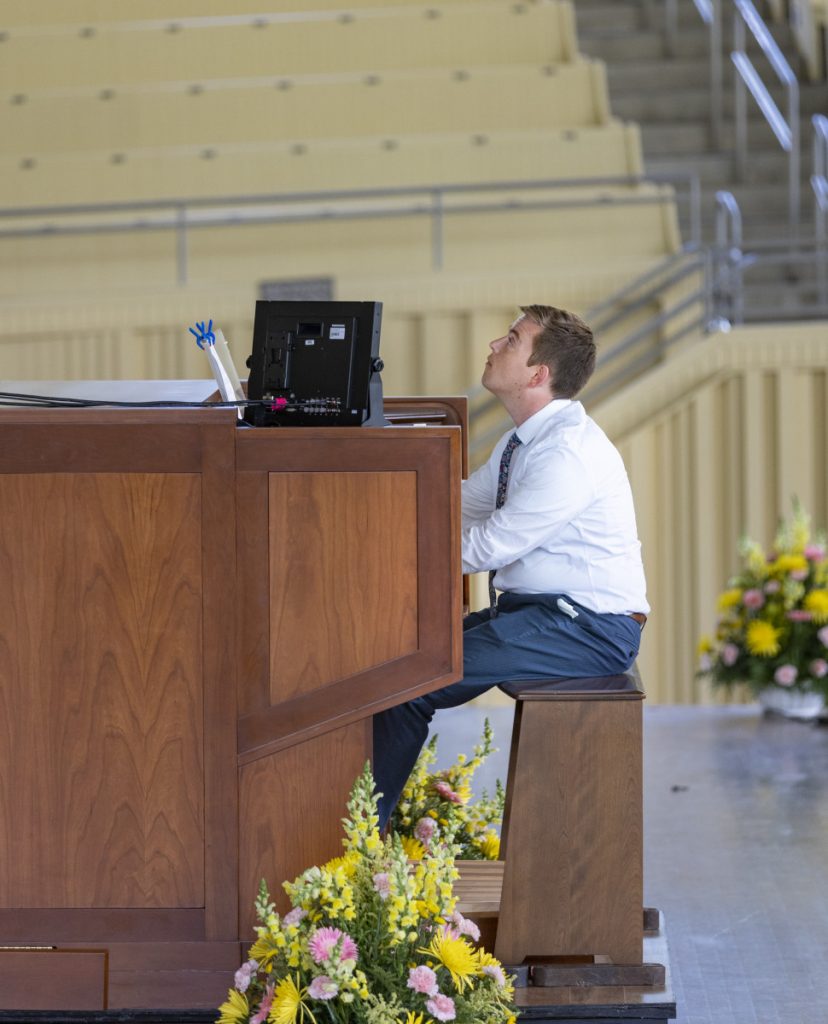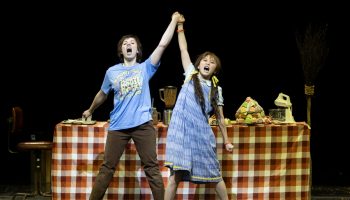NICHOLE JIANG – STAFF WRITER

Installed in 1907, Chautauqua’s Massey Memorial Organ has stood at the heart of the community for over a century now. This weekend, it will be the star of the show as director of sacred music Joshua Stafford, who holds the Jared Jacobsen Chair for the Organist, officially performs with the Chautauqua Symphony Orchestra for the first time at 8:15 pm. Saturday in the Amphitheater.
The organ itself is such an integral part of the community, and its rich sounds have the ability to fill the Amp like no other instrument. However, Saturday’s sounds will be an entirely different experience as Stafford performs Felix-Alexandre Guilmant’s Symphony No. 2, Op. 91 as a soloist with the CSO. The CSO will also perform Antonín Dvořák’s Symphony No. 9 in E minor, Op. 95, “From the New World.”
“Most of (the organ’s) original pipework is intact, despite having been rebuilt three times. What’s special about it is there’s a variety of color, especially in the foundation tones that you don’t hear in many American organs,” Stafford said. “Especially with the orchestra, it’s going to be particularly beautiful in the way it’s able to move in and out of the orchestral sound; … it’s all the color that this organ has to offer, and also the way that a 1907 instrument is able to fill a building like this is really incredible.”
The Massey, alongside the orchestra, will offer a rich sound that will travel effortlessly throughout the entire Amp.
“Blending an organ with an orchestra is actually really nice, because it’s an instrument that stands up really well on its own, to the full strength of an orchestra,” said Karl Pedersen, violist. “I think everybody’s really excited to get it up and cranking and see what it’s really capable of.”
Stafford is excited for this opportunity to showcase his talents alongside the CSO on such a historic and significant instrument.
“As an organist, we are so often just soloists. We’re doing our own thing,” Stafford said. “I love orchestral music, but so rarely get to participate in it, so it’s nice to be part of the group for once. I think the Massey Organ, to a lot of people, is really a central part of Chautauqua. The Amphitheater is the heart of Chautauqua, and the Massey is the center of the Amphitheater. So, even if people don’t hear the organ every day, they see the Massey every day, and it’s such an important part of Chautauqua life.”
Saturday’s collaboration is also the beginning of a musical future for Stafford and the CSO.
“Josh is in his official first year as an organist in Chautauqua, and because he has such a prominent role in the religious component of the Institution, I thought it would be very important for us to also include him in our CSO concert as a soloist,” said Rossen Milanov, music director and conductor. “It’s the first time that I will be collaborating with Josh, so I’m looking forward to getting to know him better musically and establishing that musical connection.”
The performance also holds personal sentiment for both Milanov and Stafford.
“I’ve personally worked extensively with organ soloists and organ music throughout my career, including several CDs that I’ve released with the Wanamaker Organ of Philadelphia, which is the biggest instrument in the world,” Milanov said. “So I know a lot of the repertoire, and I always enjoy collaborating with organ players, so there’s a personal note.”
Stafford himself has always admired this aspect of Milanov’s musical career.
“I’m especially looking forward to working with Rossen,” Stafford said. “Some of my organ friends I know say he’s one of the best conductors for organists. Rossen actually conducted what I think was my favorite concert I ever went to in my life, which was at Macy’s in Philadelphia. It just blew me away.”
Stafford and the CSO will open Saturday’s performance with Guilmant’s Organ Symphony No. 2. This piece was originally written as an organ sonata that Guilmant later rearranged for both organ and orchestra. This piece is the perfect blending of the organ with the orchestra as the two sounds weave in and out of each other.
“I think one of the best moments is the first organ entrance of the piece,” Stafford said. “You’ll feel it more than you’ll hear it, which I think is going to be really great. It goes from that sort of quiet rumble, and then it builds and builds and gradually you’ll hear the organ start to fill out through the orchestra, occasionally overtake it, and then it’s that play back and forth, that’s really fun. Then there are also some really beautiful, quiet moments of organ solo, where you can hear the great colors of the Massey.”
This specific piece pairs the sounds of the organ with the orchestra, while simultaneously allowing it to become the center of attention at times.
“There are extensive parts for the organ, but there is also a very important part for the orchestra. And so it’s an interesting kind of a distribution of what the organ does,” Milanov said. “In some movements, the organ takes the biggest weight musically and in some of the other movements it’s exclusively just the orchestra. There are a lot of possibilities that present themselves in the hands of a good composer to see exactly what kind of collaboration could exist between the organ and orchestra. And in this case, there will be so many different solutions that I think would be very interesting for the audience to even try to distinguish sometimes when the orchestra’s playing and when the organ is.”
The concert will then close with Dvořák’s Symphony No. 9 in E Minor, Op. 95, “From the New World.” This piece is incredibly well known — Neil Armstrong even took a recording of the symphony to space for the first moon landing in 1969. Often described as being one of the best known symphonies, this four-movement piece has become a symbol of “American” music.
“One of the advantages that we have this summer is to showcase how many different musical formations Dvořák composed,” Milanov said. “We already heard in this (season) both his wind serenade and his string serenade, and now we are going to do something utilizing the entire symphony orchestra. This symphony is interesting, not only because it’s one of the most popular works in the repertoire, but because it was composed here in the United States. The second movement is pretty much inspired by what would later be considered sort of the first examples of Americana in classical music. I think this work, even though written by a Czech composer, stands very high on the pedestal of symphonic works and is deservingly popular among the audiences.”
Milanov said Saturday’s performance is an opportunity for the community to experience the full sound of the CSO.
“We will start featuring larger and larger works for the orchestra as we move toward the end of our residency,” he said. “In my opinion, this is very close to what Chautauquans remember from previous seasons.”




